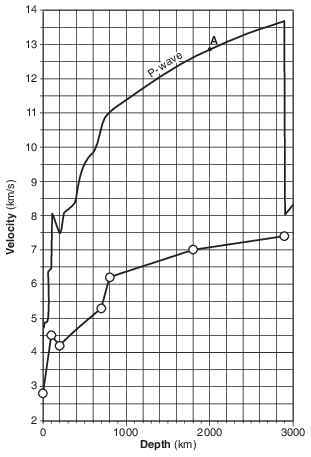Topic: Earth Dynamic Interior
Earth Dynamic Interior
Which layer of Earth’s interior is inferred to be composed of solid iron and nickel?
(1) asthenosphere
(2) stiffer mantle
(3) outer core
(4) inner core
The first S-wave reaches a seismic station22 minutes after an earthquake occurred. How
long did it take the first P-wave to reach the same seismic station?
(1) 8 minutes 50 seconds
(2) 10 minutes 00 seconds
(3) 12 minutes 00 seconds
(4) 12 minutes 50 seconds
Which graph best shows the range of density in each of Earth’s layers?
(1) 
(2) 
(3) 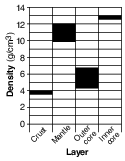
(4) 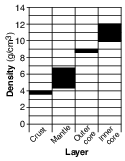
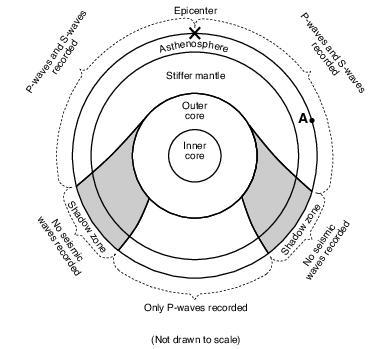
Point A is located 7600 kilometers from the epicenter of this earthquake. How many minutes did it take the first S-wave to reach point A?
(1) 9 min
(2) 11 min
(3) 16 min
(4) 20 min
A P-wave takes 5 minutes to travel from the epicenter of an earthquake to a seismic station. Approximately how many minutes will it take an S-wave to travel that same distance?
(1) 15 min
(2) 12 min
(3) 9 min
(4) 4 min
Which two Earth layers are separated by the Moho boundary?
(1) rigid mantle and plastic mantle
(2) outer core and stiffer mantle
(3) stiffer mantle and asthenosphere
(4) crust and rigid mantle
The map below shows changes in the position of the tsunami wave front produced by the 1964 Alaskan earthquake. The numbers indicate the time, in hours, for the wave front to reach the positions indicated by the isolines.
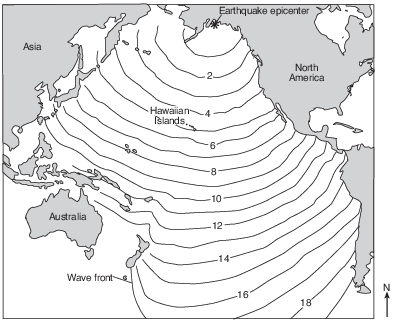
If the wave front reached the Hawaiian Islands at 10:30 p.m., at approximately what time did the earthquake occur?
(1) 1:30 p.m.
(2) 5:30 p.m.
(3) 3:30 a.m.
(4) 4:30 a.m.
The diagram below represents the analysis of a seismogram used to calculate an earthquake’s magnitude on the Richter Scale. This seismogram shows the difference in arrival times, in seconds, of the first P-wave and S-wave and the amplitude of the S-wave in millimeters.

The diagram below represents how the earthquake’s magnitude is determined by drawing a line connecting the difference in arrival times of the P-wave and the S-wave, and the S-wave amplitude.

What is the magnitude of a recorded earthquake if the difference in arrival times of the first P-wave and S-wave is 2 seconds and the S-wave amplitude is 20 millimeters?
(1) 3.8
(2) 2.0
(3) 3.0
(4) 4.8

Which data best describe the depth below Earth’s surface and the density of Earth’s interior at location W?
(1) Depth: 600 km Density: changes from 3.4 g/cm3 to 5.6 g/cm3
(2) Depth: 1000 km Density: averages 4.5 g/cm3
(3) Depth: 2900 km Density: changes from 5.6 g/cm3 to 9.9 g/cm3
(4) Depth: 5100 km Density: averages 11.1 g/cm3
How long after receiving the first P-wave from an earthquake centered 4000 kilometers away does a seismic station receive its first S-wave from the same earthquake?
(1) 1 minute
(2) 5 minutes 35 seconds
(3) 7 minutes
(4) 12 minutes 40 seconds
Which evidence recorded at seismic stations following an earthquake supports the inference that Earth’s interior changes from solid rock to molten iron and nickel at the mantle-core boundary?
(1) P-waves arrive earlier than S-waves.
(2) P-waves and S-waves are both recorded at all stations.
(3) Only S-waves are recorded at all stations.
(4) Only P-waves are recorded on the opposite side of Earth.
The pressure at the interface between Earth’s outer core and inner core is inferred to be
(1) 0.2 million atmosphere
(2) 1.5 million atmospheres
(3) 3.1 million atmospheres
(4) 3.6 million atmospheres
On February 27, 2010, a strong earthquake with a magnitude of 8.8 occurred off the west coast of South America near the city of Concepción in central Chile. There was tremendous damage to the region and loss of life, as buildings collapsed. Tremors were felt as far north as Ica, Peru, 2400 kilometers away. The earthquake triggered a tsunami that damaged several coastal towns. Tsunami warnings were issued to 53 countries, including the United States, where damage was reported. This earthquake is ranked as one of the highest in magnitude ever recorded by a seismograph. Chile has experienced some of the strongest earthquakes in the past, including a 1960 earthquake that had a magnitude of 9.5, the highest ever recorded.

Determine the P-wave travel time, in minutes and seconds, from this earthquake’s epicenter to the tremors that were felt in Ica, Peru. [1]
___________ min ___________ s
Allow 1 credit for any value from 4 min 40 s to 4 min 50 s.

Some of the magma at the Galapagos Hot Spot is believed to originate 1000 kilometers below Earth’s surface. What is the approximate temperature of Earth’s interior at that depth? [1]
°C
Allow 1 credit for any value from 3100°C to 3300°C.

On the graph in the image provided, plot the S-wave velocity at each depth given on the data table. Connect the plots with a line. [1]
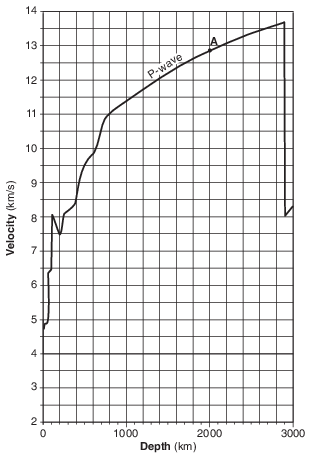
Allow 1 credit if the centers of all seven student plots are within or touch the circles shown below and are correctly connected with a line that passes within or touches the circles.
• Note: Allow credit even if the student extends the line beyond 2900 km.
• It is recommended that an overlay of the same scale as the student answer booklet be used to ensure reliability in rating.
• 